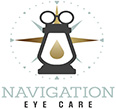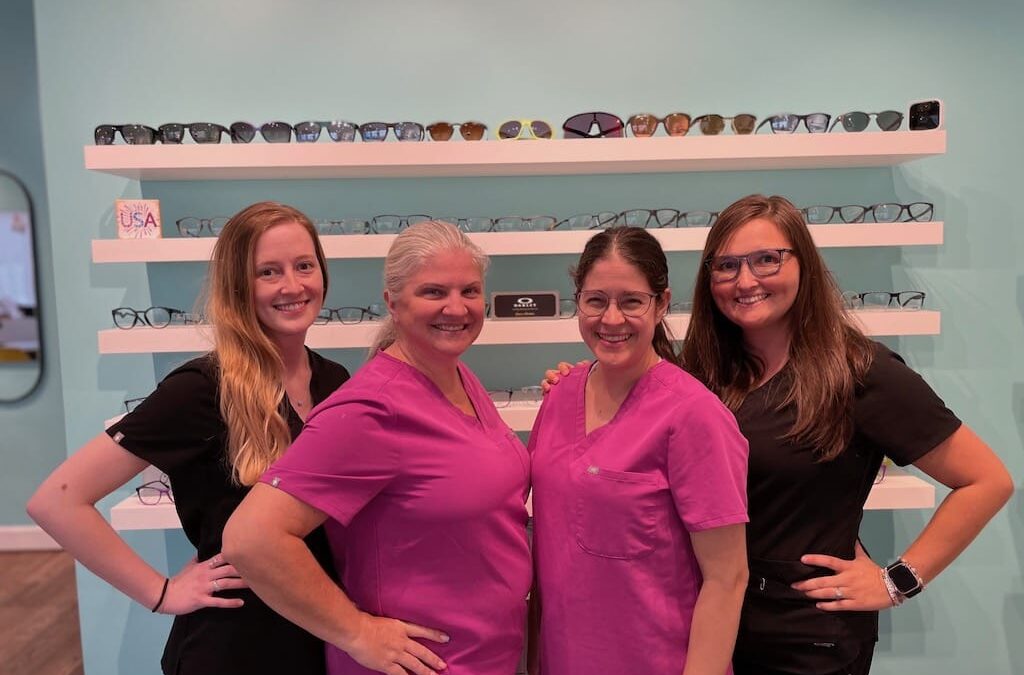Children with Astigmatism
By: Dr. Amber Teten, Optometrist Chesapeake VA
Astigmatism is a common eye condition that can be identified in children. It can also be confusing and overwhelming for parents that have a child with astigmatism. Dr. Teten, an Optometrist Chesapeake VA, looks to provide comprehensive information about astigmatism in children, its causes, symptoms, and treatments.
What is astigmatism?
Astigmatism is a refractive error that occurs when the cornea or lens of the eye has an irregular shape, leading to blurred vision. The cornea is the transparent layer covering the front of the eye, and the lens is located inside the eye. In a normal eye, the cornea and lens are smooth and evenly curved, allowing light to pass through and focus on the retina, which sends visual signals to the brain. However, in the case of astigmatism, the cornea or lens is unevenly curved, causing the light to scatter and focus on multiple points instead of one, leading to blurry and distorted vision.
Astigmatism in Children:
As an Optometrist Chesapeake VA specializing in pediatrics, Dr. Teten has seen many cases of astigmatism in children and understands its impact on their vision and daily life. Astigmatism can cause blurred or distorted vision, affecting a child’s ability to read, write, and see the board in the classroom. This can lead to headaches, eye strain, and difficulty concentrating, impacting their academic performance and overall quality of life.
Children with astigmatism may also experience difficulties with depth perception, making it challenging to participate in sports or other activities requiring accurate depth perception. Additionally, children with astigmatism may need to tilt their head or squint to see clearly, which can cause eye fatigue and further exacerbate the symptoms of astigmatism.
Causes of Astigmatism in Children:
The exact cause of astigmatism in children is not fully understood, but it is believed to be primarily genetic. Astigmatism can be present at birth or develop during childhood as the eyes grow and change shape. Some children may develop astigmatism due to an eye injury, surgery, or a condition like keratoconus. Some medical conditions like diabetes or thyroid disease may also increase the likelihood of developing astigmatism.
Symptoms of Astigmatism in Children:
The symptoms of astigmatism in children can vary depending on the severity of the condition. Some children may have mild astigmatism and experience no symptoms. In contrast, others may have more significant astigmatism that affects their vision and daily life. Common symptoms of astigmatism in children can include blurred or distorted vision, particularly at a distance, eye strain, headaches, and difficulty reading or writing. Children with astigmatism may also squint or tilt their head to see more clearly, which can cause eye fatigue and further exacerbate their symptoms.
In some cases, astigmatism in children can also lead to difficulties with depth perception, making it challenging to participate in sports or other activities that require accurate depth perception. Additionally, some children may experience double vision or see halos around lights, particularly at night. Parents may also notice their child rubbing their eyes frequently or complaining of eye discomfort or fatigue.
It is essential to bring your child to an Optometrist Chesapeake VA that specializes in pediatrics if they are experiencing any of these symptoms or have a family history of astigmatism. Early detection and treatment of astigmatism can help prevent further vision problems and ensure optimal vision and eye health in children.
Diagnosing Astigmatism in Children:
Dr. Teten, as an Optometrist Chesapeake VA that specializes in pediatrics, utilizes several methods and tests I can use to identify if a child has astigmatism. One of the most common tests is a comprehensive eye exam, which includes several visual acuity assessments and eye health. During a comprehensive eye exam, I will typically perform the following tests:
- Visual acuity testing: Using an eye chart, this test measures the clarity of a child’s vision at various distances.
- Refraction testing: This test uses a phoropter to determine the refractive error in a child’s eyes and identify any astigmatism.
- Keratometry: This test measures the cornea’s curvature using a special instrument called a keratometer.
- Corneal topography: This test uses computerized imaging to create a detailed map of the cornea’s surface, allowing for a more precise diagnosis of astigmatism.
- Retinoscopy: This test uses light to evaluate the reflection of light off the retina and determine the eyes’ refractive error.
Additionally, Dr. Teten may use a variety of specialized instruments and techniques to evaluate the health of a child’s eyes, including examining the pupils, assessing eye movement and coordination, and measuring intraocular pressure. By combining these different tests and assessments, Dr. Teten can accurately diagnose astigmatism in children and provide appropriate treatment to ensure optimal vision and eye health.
Treating Astigmatism in Children:
The treatment of astigmatism in children depends on the severity of the condition. No treatment may be necessary in mild cases, and the child can be monitored with regular eye exams. However, if astigmatism affects the child’s vision and quality of life, treatment may be necessary.
One of the most common treatments for astigmatism in children is the prescription of corrective eyewear, such as glasses or contact lenses. These corrective lenses can help compensate for the cornea’s irregular curvature, allowing the child to see more clearly and reducing symptoms such as eye strain and headaches.
In some cases, vision therapy may also be recommended. Vision therapy is a non-invasive treatment that uses exercises and techniques to improve visual acuity and eye coordination. This can be particularly useful in children with moderate to severe astigmatism or in cases where glasses or contact lenses are not appropriate or effective.
As an Optometrist Chesapeake VA, Dr. Teten always works closely with parents and children to ensure the best possible treatment plan is developed based on the child’s individual needs and circumstances. Regular eye exams and early astigmatism detection are crucial for ensuring children’s optimal vision and eye health.
Astigmatism is a common vision problem that affects many children. Identifying and treating astigmatism early is important to ensure optimal vision and eye health. While astigmatism can cause blurry or distorted vision and other uncomfortable symptoms, effective treatment options are available, including corrective eyewear and vision therapy. By working closely with parents and children, Dr. Teten can develop a tailored treatment plan that meets the child’s individual needs and circumstances. Additionally, regular eye exams are essential for the early detection of astigmatism and other vision problems, allowing for timely intervention and management. By understanding the causes, symptoms, and treatment options for astigmatism in children, we can ensure that children can see the world clearly and comfortably, setting them up for a lifetime of healthy vision.
If suppose you suspect you or your child have astigmatism. In that case, we encourage you to schedule an appointment by calling the Navigation Eye Care team at 757-529-6889 or by scheduling an appointment through our website. You can meet with Dr. Teten to discuss any of your concerns and be set up with a personalized treatment plan. We are equipped and prepared to care for you and your whole family. If you are looking for excellent service in a friendly manner, check us out. We highly recommend that you choose Navigation Eye Care when looking for an Optometrist Chesapeake VA.

